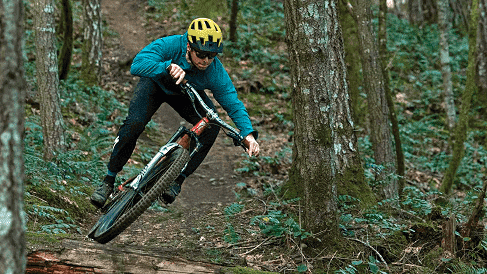Carbon is unquestionably the greatest material for mountain bikes. Suppose you are looking to find out more about carbon mtb frames. And you’re planning to acquire a carbon mountain bike then stick around! It’s because we’ve made it clear to you.
- Part 1: Why Carbon Is The Best Choice
- Part 2: Myth About Carbon Material
- Part 3: How to Take Care of Carbon Mountain Bike Frame
- Part 4: Carbon MTB Frames Products
- Part 5: Frequently Asked Questions
- Part 6: Summary
Part 1: Why Carbon Is The Best Choice
Carbon fiber has been a key motive for some of the most significant technological advancements in mountain biking and other sports. Its supremacy is based on a number of factors, including high tensile strength and stiffness, longevity, integrity, minimal thermal expansion, limitless design options, and comfort and handling.
The primary advantage of carbon bikes and components is their lightweight, which is especially obvious when riding through challenging terrain. The difference in weight loss is evident, much more so as a cyclist becomes exhausted. Carbon fiber bikes are lightweight, allowing riders to spend more time on the hills enjoying their riding without feeling bogged down.
Additionally, the material is far tougher and more durable than aluminium. Aluminium bike frames and components deteriorate with repeated movement and stress, making them more prone to crack.

-
Environmental Credentials of Carbon
When it comes to carbon, it’s important to know that there is some real concern about how it will affect the environment. However, it’s important to look at carbon footprints in the big picture. Research shows that aluminium and carbon bikes don’t have very different carbon footprints when looking at how much energy they use and how the environment changes over time. Carbon fiber is a lot of work, but it doesn’t rust, corrode, wear out, or break down. It means that carbon bike parts have a much longer lifecycle than aluminium parts, which will need to be replaced many times during the same time period. That’s why it gives carbon a big advantage when it comes to the full lifecycle impact of its parts.
Aluminium is currently easier to recycle than carbon in terms of waste. Thankfully, a dependable carbon recycling technology is already making steady progress in reducing the material’s footprints, but it isn’t cheap! It entails a process known as “pyrolysis”, which means “burning down”. The carbon fiber is heated to extremely high temperatures in an oxygen-free atmosphere, preventing it from catching fire. The excess materials melt away, leaving just clean carbon fibers that can be reused.
Carbon is undoubtedly the future’s material, and if governments can encourage recycling, this will help carbon’s footprint. Carbon fiber is now used in 90% of high-performance sports, from tennis racquets to hockey sticks to boat masts and sails. Its high quality and durability make it a treasure.
-
Versatility and Creativity
Carbon fiber is a good thing because it lets bike designers be more creative with the shape of their bikes. Because the material is so versatile, there are so many different ways to make it. It can be made into any shape and weighs less than aluminium, but it is also more durable. With the rapid development of new computer programs, designs can now be rigorously tested for strength before they are made. This combination of a versatile material and modern computer software allows for more creative freedom, which means that bikes will become more advanced, be more unique, and perform better in the future.
The cost is still high because the process is very time-consuming. As 3D printing becomes more common, this should become less of a problem. On the other hand, Carbon bikes will still be made by hand, which means they will cost more. The cost of the dedicated and skilled teams that work together to make these elaborate frames is a good reflection of how much work it takes to make them.
Part 2: Myth About Carbon Material
-
Myth: A Carbon Frame Won’t Last As Long As A Metal one
Fact: When carbon bikes aren’t used, they can last for a long time. It only takes steel and aluminium a certain amount of time before they break down and can no longer be used properly. On the other hand, carbon stays the same for an infinite amount of time.
-
A Professional should Look at Your Frame After a Crash to Ensure There Aren’t any Broken Parts
Fact: Most of the cracks that could weaken the structure of your bike can be easily seen. Snags can be found by running a soft cloth over them. If you have any questions or concerns, contact the manufacturer or a carbon-repair shop that is known for its work. They can use an ultrasonic wave reflector or an infrared camera to look for signs of damage in the area.
-
Carbon Bikes are more Likely to Break than Aluminium or Steel Bikes
Fact: Carbon frames are relatively strong, but they can handle a lot of force if used in the way the engineers wanted. For example, if you hit a pothole on the road, the frame can handle the shock. A tree could fall on you, or you could step on the chainstay. If the force comes from a different direction than expected, the material would likely break.
-
There is A Risk that the Sun will Damage Your Carbon Frame
Fact: It’s safe. People who make bikes use UV-resistant paint and waxes to help shield the frame from harmful rays.
Part 3: How to Take Care of Carbon Mountain Bike Frame
-
Everyday Care
Some simple steps can make sure that your carbon bike will be long-lasting. To make things easier, you can park it safely. You don’t want it to roll and fall on its side or hit anything. Keep your seat or frame away from a pole even if you think it’s safe, even if you put it there gently. The bike could move, causing the frame to hit the pole, which could damage it. There is a chance that the handlebars could swing around and hit the top tube. Place the bike in a safe place when you park it or make sure it’s on a level surface.
-
Crash and Wear-and-Tear Checks
If you crash or abuse your bike, you should look for signs of damage or forget that it’s on the roof rack and ram it into your garage. People who aren’t good at looking at things might not notice that something is wrong right away. So please bring it to the shop. They will be happy to look at it and give you some advice. Make sure the bike or part is safe before you ride. Even if you never crash, you should always check your carbon bike and parts for gouges, deep scratches, loose fibers, or other surface cracks.
-
Cleaning and Washing
Carbon bikes and parts can be washed with warm soapy water, just like you would with any other type of bike or part. Even so, it’s not a good idea to point the water directly at bearings on a bike, like the headsets, cranks, etc. Also, a bike polish or spray wax can help protect your bike after being cleaned, rinsed, and dried.
-
Repainting
Your bike might need new paint at some point. It must be done the right way and with a lot of care. You should hire a professional bike painter who can work with carbon frames. Any paint stripper that can remove polyurethane or urethane paint will also damage the epoxy resin matrix that holds your carbon together. Also, you should not sandblast, bead blast, or blast with any other media to remove the paint because that could damage the frameset. This could make the bike fall apart. It’s best not to paint over the decals, but you should carefully sand off the old finish with a hand sander if you do
Part 4: Carbon MTB Frames Products
-
Fezzari La Sal Peak ($3600)
Horst Link suspension is used on the La Sal Peak to get that 150mm of rear travel. A carbon rocker link connects the top tube and seat stays and drives the shock through them. With 27.5+ wheels, a flip chip can make the head angle steeper and raise the bottom bracket. Other than that, it’s a pretty simple and straightforward set-up that’s easy to figure out.
Fezzari says that with 30 per cent sag in the 32/50 tooth gear combination, the anti-squat percentage is at 114 per cent. As the bike moves through its range, the percentage goes down. It has a rising rate suspension with a 24 per cent change in leverage ratios between the start and end of the ride. The bike should work well with both air and coil-sprung shocks.
-
Transition Sentinel Carbon NX ($4100)
This bike is called the Transition Sentinel Carbon NX. Also, this bike is made of carbon fiber mountain bike frame. You can get it in sizes SM, MD, LG, XL. It has 29-inch wheels. It also has RockShox suspension and a drivetrain from SRAM. Furthermore, the bike is part of Transition’s SENTINEL line of mountain bikes, and it has a lot of gear.
If you’re looking for a carbon bike but don’t want to spend much money, the Sentinal Carbon NX is the best option. It has good parts and a good suspension. Rockshox suspension takes care of the suspension. An NX Eagle comes with everything you need to get up and down. It has the same huge gear range as the GX and XO1 Eagle. Also, you get KS Lev Integra dropper post and Maxxis Minion Dual tyres with your bike. You don’t need to buy any other parts right away.
-
Salsa Redpoint SLX 1X11 ($4100)
When Salsa Redpoint has a 66.4-degree head angle, it looks like it has all the right geometry numbers, like 150mm rear/160mm front travel. A dropper post and a Split-Pivot suspension system make this bike ready to climb the steepest of hills. It is because the chainstays are 430mm (16.9 inches) long. It means that bigger tyres can fit. A Santa Cruz Bronson model has a reach of 425mm. The medium frame has a reach of 441, which is a lot longer than that. At 13.5 inches, the BB height is just right. For the SRAM XO1 build.
Part 5: Frequently Asked Questions
- Gow much does it cost for repairing a carbon frame?
Shop around to find a good carbon fiber repair shop. Often, a top carbon fiber repair shop will be able to match the paint on your frame. This means that your frame will look as good as new. $150-250 to fix a small area of damage. For a medium area of damage, it will cost between $250 and 350. Lastly, A large of damage will cost between $400 and 450.
- Can I buff my carbon fiber mtb frame?
They may lose their shine over time. So, yes, you can buff and polish carbon frames to remove swirls and make them shine more. You can also wax and seal them like you would your car.
- Is a torque wrench required while working on carbon frames?
Indeed, torque wrenches are significantly more critical when working with carbon frames and components, as carbon does not bend much before breaking. A torque wrench is ideal for working on carbon frames because it allows you to precisely set the torque (tightness) without risk of damage. Even top bike mechanics cannot torque bolts to the proper torque without using a torque wrench.
- How long are carbon mountain bike frames made to last?
Carbon frames are usually last for at least 5 or 6 years if used a lot. How long your bike frame will last will depend on what kind of riding you do (road, MTB, BMX), and how careful you are with it. Many modern carbon frames are becoming more durable and usually have a better build quality. It means that carbon frames and other parts will last longer. However, a steel or aluminium frame can last for 7 to 10 years.
On the other hand, carbon has a little more work to do. However, if the carbon fiber is built well, the resins are used correctly, and the frame doesn’t get damaged, it could theoretically last long. Carbon fiber doesn’t rust or wear out like metal frames, so it could theoretically last for a long time.
Part 6: Summary
Carbon fiber bikes are lighter, stronger, and last longer than aluminium bikes. Repeated movement and stress weaken aluminium bike frames and parts, making them more prone to cracking. When compared to aluminium bike parts, carbon parts last a lot longer and don’t need to be replaced as often. Carbon fiber is becoming more common in tennis racquets, hockey sticks, and other high-performance sports. You can shape it in any way you want, but it’s also more durable than aluminium, which is lighter.
When computer programs get better, designers are able to come up with more unique bike ideas. Carbon frames are strong, but they can take much damage if they aren’t handled properly. Store the bike in a safe place or surface level when you’re done riding. Keep an eye out for damage to your carbon bike and its parts, even if you haven’t crashed. If you decide to paint over the decals, use a hand sander to get rid of the old finish.









